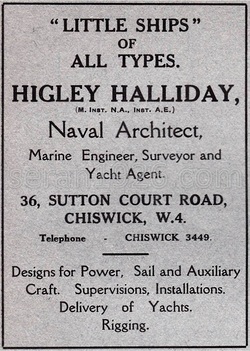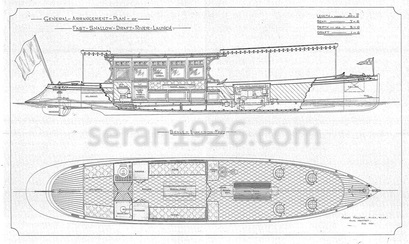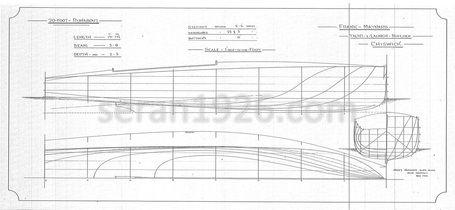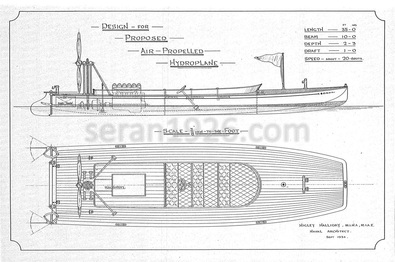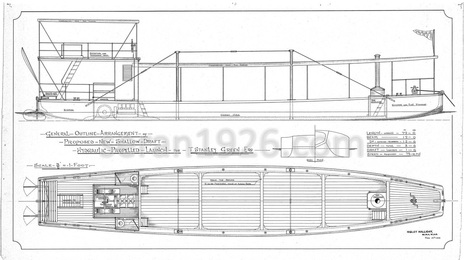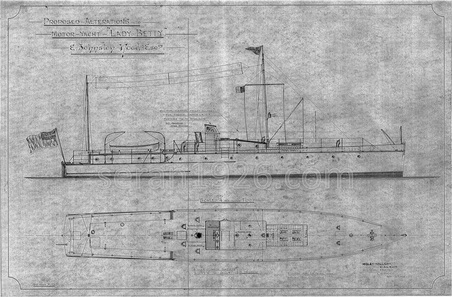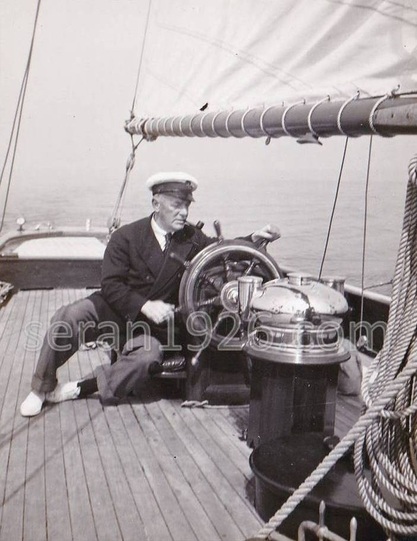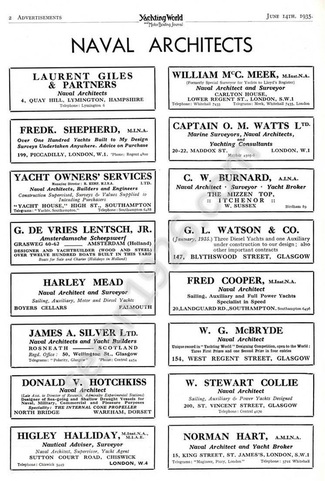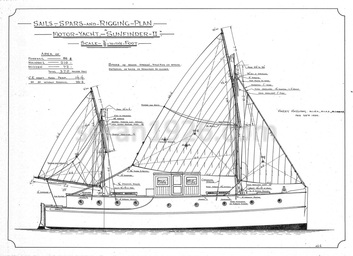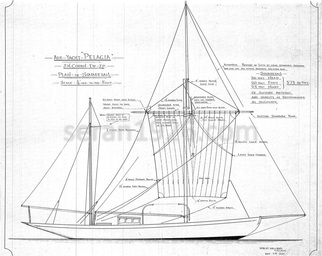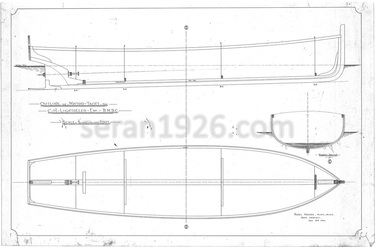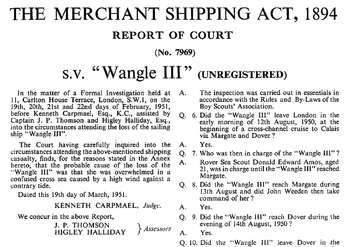V. "Little Ships" of all types
For one man, Halliday demonstrated an enormous breadth of
experience and competence, designing a diverse range of recreational and
commercial vessels powered by marine motor engine and other less conventional
means.
Launches
The majority of Halliday’s launch designs were fitted with
petrol and / or paraffin motors and were typically fast motor
launches or more functional harbour launches of between 20 ft. and 30 ft.
Of particular note, is his design for a 40 ft. motor launch for H. H. The
Sultan of Perak (1924), intended for State service. The launch was
completed in 1926 by Taylor and Bates, Chertsey and reviewed in The Motor Boat,
30 April 1926.
Other launch designs of this period used a variety of
different means of propulsion. Several outline designs for steam patrol
launches survive, the last dating from 1923. Other intriguing designs
include an air-propelled hydroplane (1925), hydraulic propelled launch
(1923) and tug (1925) and electric launch (1924).
A number of designs for passenger launches have also
survived: a 50 ft. passenger launch designed to carry 100 passengers, plying
from Eastbourne (1923) and a 40 ft. launch designed to the Board of Trade
requirements for a steam “6” certificate (1925). Both were built by
Maynard’s yard.
Consultancy
As the 1920’s progressed, Halliday increasingly focussed on
consultancy projects including modifications to existing vessels, sail plans
and re-engining cruisers and auxiliary yachts. Examples of his work at this
time include: a design for a balance lugsail for a 26 ft. sailing punt
(1925); sail and rigging plans for a 14 ft. sailing dinghy (1926), a design for
electric submerged log (1926); design for anchor davit for a 35 ft. motor
cruiser (1927); modifications to the design of a range of craft including the
80 ft. motor yacht ‘Lady Betty’ (1926), owned by Count Johnston-Noad, member of
the British Motor Boat Club. This, together with his work at the Little Ship
Club increasingly became his focus.
Whilst the 1920’s may have been Halliday’s most productive
period in terms of vessel design, in the
1930’s there was a greater focus on consultancy work, in particular on
auxiliary and sailing craft. Whilst Halliday spent much of his professional
life working as a marine engineer and designer of principally powered
craft, he was a keen sailor and between 1906 and 1910 owned ‘Minx’, a wooden
centre board sloop of 3 tons, built 1900 by Bathurst, Tewkesbury and
‘Nanette’ a 1 ton sloop built by Dixon Bros, Southampton in 1906. In the
1950’s he co-owned ‘Sally’ a 16 ft. sailing dinghy designed by F. C. Morgan
Giles and built in 1933, with J. H. Corah, who he had worked
professionally with for many years. His yachting exploits are not
fully known but he is believed to have crewed aboard King George V’s
yacht, 'Britannia' and was the Honorary Seamanship Instructor of the Little
Ship Club from 1928.
By the mid 1930’s Halliday was advertising his
services in the yachting press as a “Nautical Adviser, Surveyor,
Naval Architect, Supervisor & Yacht Agent” alongside Laurent Giles, Fred
Shepherd, James Silver, Donald Hotchkiss, G. L. Watson and W. G. McBryde
amongst others and was listed in the Yachtsman’s Annual and Who’s Who
(1938).
Examples of his work during this period include
the re-rigging of Rendle F. Holmes’s yacht ‘Amazon’, working alongside
Cubitt’s Yacht Basin Ltd., Chiswick and Kaygee Contracts when 'Amazon'
was re-powered and refurbished in 1938. Halliday designed numerous sail
plans: ‘Sunfinder II’ (1930), the motor yacht owned by W. M. Jameson
(Halliday is mentioned in book “Sunfinders: A Floating Home”, 1937); a
sail & rigging plan and the installation of a new engine in the
auxiliary motor yacht ‘Bill Adams’ (1930) and an unusual square sail
plan for J. H. Corah’s auxiliary yacht ‘Pelagia’ (1937) amongst
others.
He continued his work designing modifications to
powered craft during the 1930’s also, including ‘Seran’ (1934), the 62
ft. Thornycroft motor yacht ‘Poisson Sorcier’ (1934) – replacing the
existing transom sterns with fashionable canoe sterns - and the
re-engining of J. H. Corah’s 58 ton, 1914 motor yacht ‘Ladybelle’ (1935).
In addition, Halliday continued to design a small number of
auxiliary yachts and motor yachts, including an outline design for C. H.
Lightoller (1930), second officer on board RMS Titanic, who subsequently went
on to acquire and convert the Dunkirk Little Ship, ‘Sundowner’.
During the war years Halliday was heavily involved in
providing training to London based members of the Royal Naval Volunteer
Supplementary Reserve at the Little Ship Club. He continued to undertake ad hoc
design and consultancy work in the late 1940's principally for L.S.C. members
before retiring from an active role in the club in 1950. He remained an
active member of the Thames Shiplover's Society and The World Ship Society, both
of which met in the basement coffee room of the Baltic Exchange, St. Mary Axe.
As late as 1951, aged 76, Halliday was appointed an Assessor in the
Formal Investigation into the loss of the sailing vessel ‘Wangle III’
owned by the Mortlake (Surrey) Group of Sea Scouts.
Higley Halliday died on 27 December 1962 at the Royal Masonic Hospital, Ravenscourt Park aged 87.
